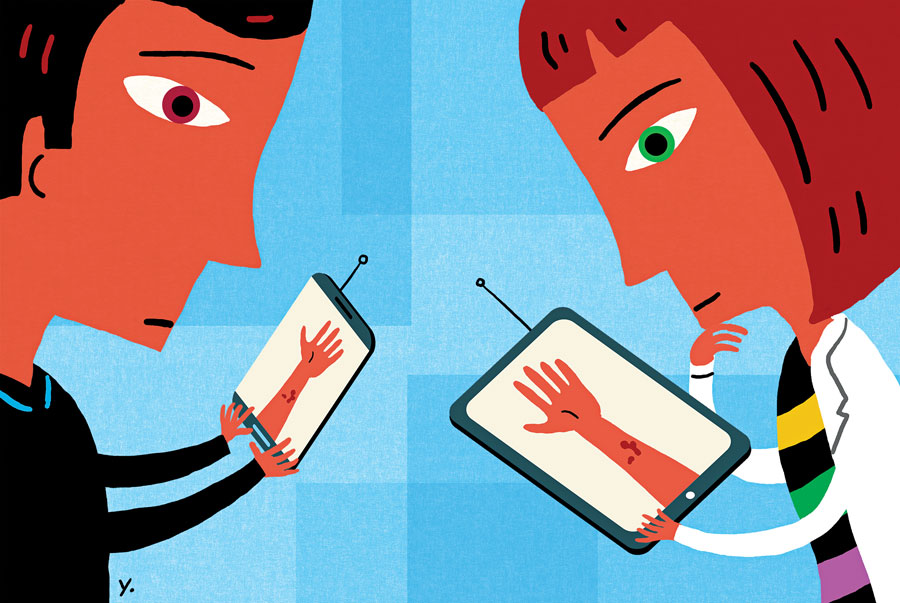Illustration by James Yang
Diagnosing skin cancer is a visual process. The trained eyes of a dermatologist have long been the state of the art. But technological advances are showing that digital tools hold a promising future to help doctors achieve earlier and more accurate skin cancer diagnoses — and engage patients to take a more active role in their own care. In part 1, we looked at total body scanners. In part 2, we learned how technology is evolving to help diagnose skin cancers at their earliest, and most curable, stages. Part 3 looks at virtual visits and how to secure your valuable medical data.
By Dan Ferber
Virtual Visits: Pros and Cons
Many patients live in areas where skilled dermatologists are scarce, and they have to travel a long way for appointments. “You can imagine that patients in a rural area, where the closest clinic might be 60 miles away, may not be getting regular skin exams or the care they need,” says Steven Q. Wang, MD, director of Dermatologic Surgery and Dermatology at Memorial Sloan Kettering Cancer Center in Basking Ridge, New Jersey. That could mean skin cancers aren’t detected early, when they’re most curable.
One solution is a virtual visit, called teledermatology. It’s a rapidly developing subspecialty using the latest technology to allow patients better access to high-quality dermatologic care without traveling to the clinic from home. Teledermatology has the potential to save time and money — and benefit patients and doctors, too.
For example, instead of going back for a follow-up visit with a dermatologist, patients can take a picture on their phone and send it to the doctor. The doctor can see if the person is getting better, call back and dispense advice on whether to stay on a medication or not. If the patient is worried about a suspicious lesion, the doctor can see if it has changed from a baseline photo and determine if the patient needs to come into the office or has nothing to worry about.
There are drawbacks, of course. “People often take really close-up pictures with bad lighting and expect us to know what it is,” says Dr. Wang. “If you want to send your doctor digital photos, learn to take a better picture.” Make sure your images are in focus, well-lit and show some surrounding skin for context. And use a secure patient portal when you can.
Even when patients send good images, limitations remain. No matter how good a photograph is, it does not tell the doctor about the texture of a skin lesion, which can be important for diagnosis. What’s more, doctors are reimbursed poorly for teledermatology, and telemedicine companies sometimes have providers other than physicians assess images. Dr. Wang says, “When there’s no dermatologist to make the diagnosis, that can sacrifice quality of care.”
How to Secure All That Valuable Data?
As in other areas of medicine, patient privacy is key, but there is no standard way to send digital photos securely and store them in a patient’s electronic health record. Centralized databases of any kind, including electronic health records, can be vulnerable to hackers, Dr. Wang says. Blockchain technology (a digital system that breaks up records and distributes the data to a network of linked computers) may help by making stored images and other medical records virtually unhackable.
With blockchain technology, there’s no central repository of data. Instead, sets, or “blocks,” of data are encrypted in a way that’s difficult to crack, then replicated and simultaneously recorded to multiple computers. Those machines serve as nodes of a network, and if hackers compromise one node, the network responds like our immune system — it excludes the infected node to protect the rest of the network. Though it’s still early in the game, Dr. Wang sees blockchain being used to secure electronic medical records and perhaps total-body photography data. “It’s a very exciting technology that should put minds more at ease,” he says.
Dan Ferber is a journalist based near New York City and a former editor at Discover magazine. He writes about science, medicine and other topics for national publications.
*This article was first published in the 2019 issue of The Skin Cancer Foundation Journal.





